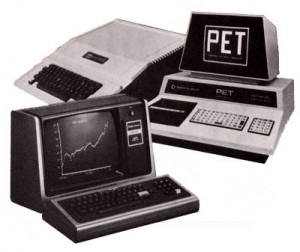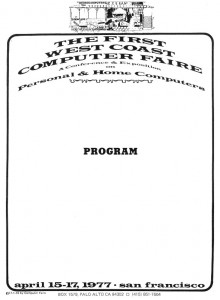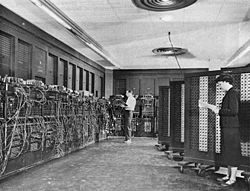Computers
Apple and Commodore

On the same day at the first annual West Coast Computer Faire, both the Apple II and Commodore PET 2001 personal computers are introduced. Ironically, Commodore had previously rejected purchasing the Apple II from Steve Jobs and Steve Wozniak, deciding to build their own computers. Both computers used the same processor, the MOS 6502, but the companies had two different design strategies and it showed on this day. Apple wanted to build computers with more features at a higher price point. Commodore wanted to sell less feature-filled computers at a lower price point. The Apple II had color, graphics, and sound selling for $1298. The Commodore PET only had a monochrome display and was priced at $795.
Note, it was very difficult finding a picture with both an original Apple II (not IIe) and Commodore PET 2001. I could only find this picture that also includes the TRS-80, another PC introduced later in 1977.
PC Industry Born

The first annual West Coast Computer Faire is held over three days in San Francisco, California, attended by 12,750 people. The Faire features the debut of the Apple II computer, which features 16KB of memory, BASIC, a built-in keyboard, eight expansion slots, and built-in high-resolution color graphics. Many credit this event and the launch of the Apple II as giving birth to the personal computer industry.
ENIAC Project Started

Researchers at the University of Pennsylvania begin work on the Electronic Numerical Integrator and Computer (ENIAC), which when completed, will become the first general-purpose fully electronic computer, capable of making calculations one thousand times faster than any other prior computer. The work will be carried out in secret since the computer is intended for military purposes, though it won’t actually be completed until after World War II ended. ENIAC will be unveiled to the public in February 1946.
Genesis of COBOL
Mary Hawes, a computer scientist for the Burroughs Corporation holds a meeting of computers users, manufacturers, and academics at the University of Pennsylvania for the purpose of creating a common business oriented programming language. At the meeting, representative Grace Hopper suggested that they ask the Department of Defense to fund the effort to create such a language. Also attending was Charles Phillips who was director of the Data System Research Staff at the DoD and was excited by the possibility of a common language streamlining their operations. He agreed to sponsor the creation of such a language. This was the genesis of what would eventually become the COBOL language. To this day COBOL is still the most common programming language used in business, finance, and administrative systems for companies and governments, primarily on mainframe systems with around 200 billion lines of code still in production use.
IBM System 360 Changes the Industry Forever

IBM launches the System 360 mainframe architecture, which comprised six compatible models complete with 40 peripherals. The line, dubbed the “360″ because it addressed all types and sizes of customer, cost IBM over five billion dollars to develop, and it is widely considered one of the riskiest business gambles of all time.
Up until this time, computer systems, even from the same manufacturer, were generally incompatible with each other. Software and peripherals from old systems would not work with new systems. This stifled acceptance and deployments of new systems as business customers were hesitant to lose their investments in their current systems. By developing a mutually compatible series of mainframes, customers were assured that their investments would not be lost if they purchased further System 360 models.
IBM’s gamble paid off handsomely as in just the first three months of its release, IBM will receive $1.2 billion in orders. Within five years, over thirty-three thousand units will be sold, popularizing the concept of a computer “upgrade” around the world. The 360 family was the most successful IBM system of all time, generating over $100 billion in revenue through the mid-1980’s. It became the basis for all subsequent IBM mainframe architectures, which would hold a 65% marketshare in the 1990’s.
The 360 architecture also introduced a number of industry standards to the marketplace, such as the worldwide standard of the 8-bit byte. Its enormous popularity catapulted the business world into the technology age and transformed the computer industry. Not bad for a bunch of suits!
Microsoft’s First Hardware Product

Microsoft announces its first hardware product, the Z80 SoftCard. The SoftCard is a microprocessor that plugs into the Apple II personal computer allowing it to run programs written for the CP/M operating system. CP/M was a very popular OS for early personal computers along with much of the software written for it. In particular, the word processor WordStar is so popular that people will purchase the SoftCard and a companion “80-column card” just to run it on the Apple II. At one point, the SoftCard product will bring in about half of Microsoft’s total revenue. It will be discontinued in 1986 as CP/M’s popularity declined.
A is for Apple

The Apple Computer company is formed by Steve Jobs and Steve Wozniak in order to sell their personal computer kits, later known as the Apple I computer, launching the personal computer revolution. From this point on, the word “Apple” is associated as much for computers as it is for fruit.
UNIVAC Unveiled

The first commercial computer, UNIVAC, is received by the US Census Bureau. Short for UNIVersal Automatic Computer, UNIVAC used over 5,000 vacuum tubes, weighed 16,686 pounds, consumed 125 kW of electricity, and could perform about 1,905 operations per second running on a 2.25 MHz clock. It was 14 feet long, 7 feet wide, and 8 feet tall.
Developed by J. Presper Eckert and John W. Mauchly, who had designed the first fully electronic computer ENIAC during World War II, the duo had formed a company in 1946 to develop a computer for the Census Bureau. Originally expected to take 6 months to begin development, it took 2 years to complete the study to design the computer. In 1950 Eckert and Mauchly sold their company to typewriter manufacturer Remington Rand and continued their work within the corporation’s calculating machine division. In 1952 the UNIVAC became famous for correctly predicting the results of the presidential election, contradicting the expected Gallup Poll results, and made the general public aware of the advancement of electronic computers.
Interestingly enough, the Census Bureau had driven the development of devices that eventually led to computers since the 1890’s and Herman Hollerith’s Punch Card Calculator.
TRS-80 Model 100 Introduced

Radio Shack introduces the TRS-80 Model 100, one of the first portable computers in a notebook-style form factor. The portability, simplicity, and built-in modem of the Model 100 made it very popular with journalists who could write stories in the field and transmit them back to their offices. Incidentally, in the early 90’s I acquired a Model 100 that had been used by a newspaper. I was able to use it to code simple programs, write papers, and use the modem to connect to bulletin board systems of the time. I currently have 2 of these models – still in good working order! Good times, good times.
First Personal Computer Convention
The First Annual World Altair Computer Convention is held in Albuquerque, New Mexico. The Altair 8800 is considered the world’s first popular “microcomputer”, which essentially was the first popular personal computer. Created by MITS which was headquartered in Albuquerque, this Altair convention is also known for being the world’s first major microcomputer or personal computer convention. Over 700 people from 46 states and 7 countries attended. The next day at the opening address, a young Bill Gates gives a talk about software piracy. Bill Gates and Paul Allen had moved to Albuquerque about a year earlier to write the BASIC programming language for the Altair, founding Microsoft.


